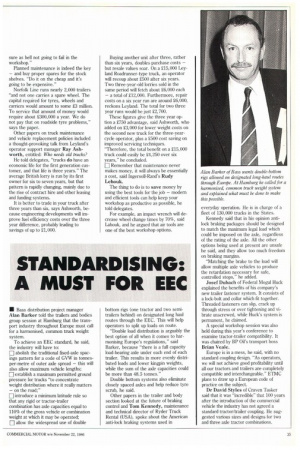STANDARDISING: A MUST FOR EEC
Page 37

If you've noticed an error in this article please click here to report it so we can fix it.
le Bass distribution project manager Alan Barker told the trailers and bodies group session at Hamburg that the transport industry throughout Europe must call for a harmonised, common truck weight system.
To achieve an EEC standard, he said, the industry will have to: abolish the traditional fixed-axle spacings pattern for a code of GVW in tonnesper-metre of outer axle spread — this will also allow maximum vehicle lengths; establish a maximum permitted ground pressure for trucks "to concentrate weight distribution where it really matters — on the road:"
n introduce a minimum latitude rule so that any rigid or tractor-trailer
combination has axle capacities equal to 110% of the gross vehicle or combination weight at which it may be operated; El allow the widespread use of double bottom rigs (one tractor and two semitrailers behind) on designated long haul routes through the EEC. This will help operators to split up loads on route.
"Double load distribution is arguably the best option of all when it comes to harmonising Europe's regulations," said Barker, because "there is a full capacity load-bearing axle under each end of each trailer. This results in more evenly distributed loads and lower kingpin weights, while the sum of the axle capacities could be more than 48.5 tonnes."
Double bottom systems also eliminate closely spaced axles and help reduce tyre scrub, he said.
Other papers in the trailer and body section looked at the future of braking control and Tom Kennedy, maintenance and technical director of Ryder Truck Rental (USA), spoke about the American anti-lock braking systems used in
everyday operation. He is in charge of a fleet of 130,000 trucks in the States.
Kennedy said that in his opinion antilock braking packages should be designed to match the maximum legal load which could be imposed on the axle, regardless of the rating of the axle. All the other options being used at present are unsafe he said, and they allow too much freedom on braking margins.
"Matching the brake to the load will allow multiple axle vehicles to produce the retardation necessary for safe, controlled stops," he added.
Josef Dubach of Federal Mogul Huck explained the benefits of his company's new trailer fastener system. It consists of a lock-bolt and collar which fit together. Threaded fasteners can slip, crack up through stress or over tightening and vibrate unscrewed, while Huck's system is permanent, he claimed.
A special workshop session was also held during this year's conference to examine tractor-trailer compatibility. It was chaired by BP Oil's transport boss Brian Veale.
Europe is in a mess, he said, with no standard coupling design. "As operators, we will not achieve good profitability until all our tractors and trailers are completely compatible and interchangeable." Ermc plans to draw up a European code of practice on the subject.
Dr David Styles of Craven Tasker said that it was "incredible" that 100 years after the introduction of the commercial vehicle the industry has not agreed a standard tractor/trailer coupling. He suggested various sizes and designs for two and three axle tractor combinations.




















































































